For most of the summer of 2025, the #1 bestseller on Amazon’s “Herbal Remedies” subcategory was The Natural Healing Handbook, written by an Australian author named Luna Filby. The book’s description claims “This is more than a book. It’s a return to natural wisdom and confident self-healing.”
Inside this 85-page book, whose paperback edition retails for US$23.97, you’ll find dozens of recipes for natural remedies based on teas, herbs, plants and other common kitchen ingredients. As of mid-October 2025, it has 518 reviews, averaging an impressive 4.7 out of 5 stars. Editorial reviews by industry experts like Sarah Wynn, founder of Wildcraft Journal, praise it as “incredibly useful” and “a visual and practical treasure”.
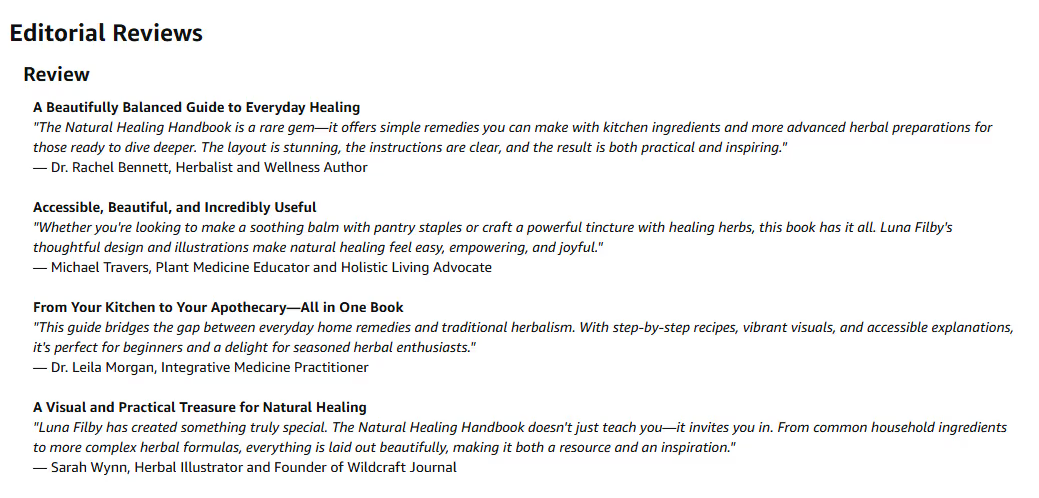
The only problem? It is likely generated by artificial intelligence.
Luna Filby does not exist, as you can tell simply by googling her name and realizing she has no digital presence outside of this one book. (What kind of author so adamantly avoids publicity?) The organization Ms. Filby claims to have founded, “My Harmony Herb”, also does not exist. None of the expert herbalists quoted above exist—not Michael Travers, the plant medicine educator; nor Dr. Rachel Bennett, the herbalist and wellness author; nor Dr. Leila Morgan, the integrative medicine practitioner; nor Sarah Wynn, the founder of Wildcraft Journal. (If it needs to be clarified, Wildcraft Journal—you guessed it—also does not exist.)
Oh, and Luna Filby herself wrote her name backwards on Amazon’s byline, calling herself “Filby Luna”, which links to a broken URL.
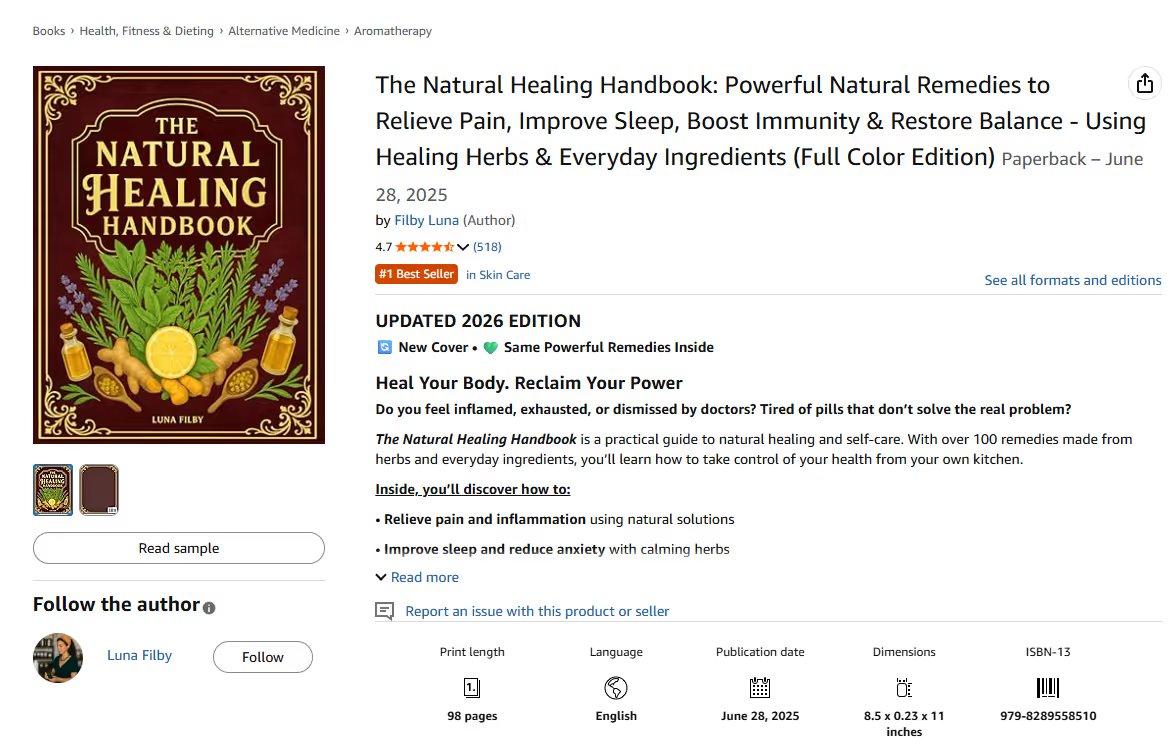
We at Originality.ai scanned The Natural Healing Handbook with our latest AI-detection model, Lite 1.0.2. We inputted Luna’s author biography, book summary and any available sample pages inside the book itself. All came back flagged as likely AI-generated with 100% confidence.
Nonetheless, through the summer of 2025, The Natural Healing Handbook skyrocketed to the #1 bestseller in multiple Amazon book subcategories, including “Skin Care”, “Aromatherapy” and “Herbal Remedies”. At one point, it ranked #2,014 among all of Amazon’s best-selling books.
The Natural Healing Handbook is not an outlier. It is a benchmark. It is the gold standard for likely AI-generated Amazon books that flat-out dominate the digital retailer, especially in niche subcategories.
And we know this, because we put hundreds of books to the test.
We used our industry-leading Originality.ai AI-detection tool to scan every notable paperback published in the “Herbal Remedies” subcategory so far in 2025, between January 1 and September 30. There were 558 qualifying titles. (There are at least four times as many books published in that subcategory and that timeframe, but to ensure we only looked at semi-serious titles, we set a minimum threshold of a four-star review average and availability in paperback.)
For disclosure, we did not purchase and scan 100% of all 558 books. Instead, we analyzed the available text pulling whatever large blocks of text each author had written. We were able to text from three categories:
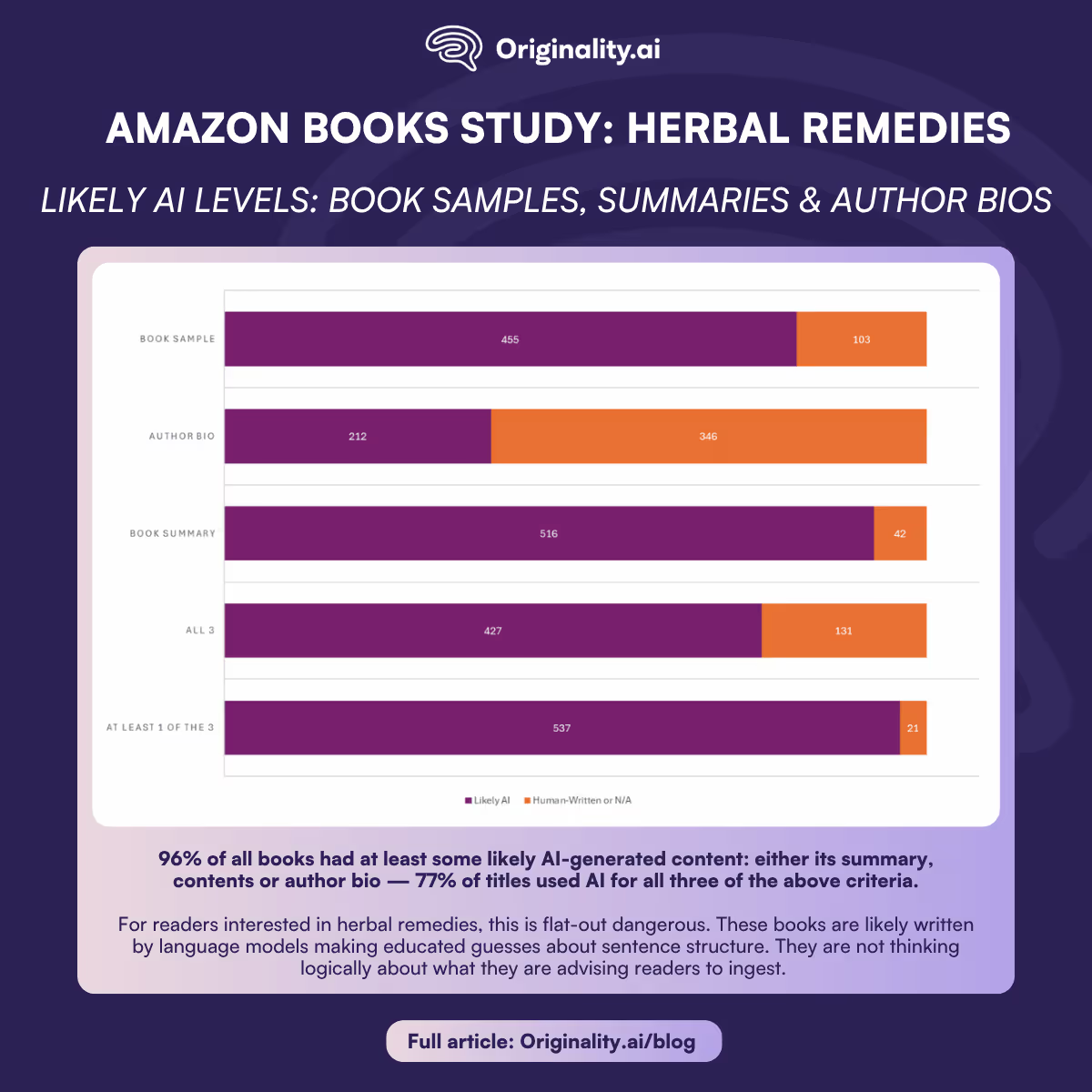
For Amazon, this is a damning revelation of the sheer scope of unlabelled, unverified, unchecked, likely AI content that has completely invaded their platform, blatantly overwhelming the amount of original human-written work.
For writers, this confirms a depressing reality: that it is harder than ever to cut through the noise of AI slop. Passionate, well-intentioned authors will struggle to draw organic sales based on Amazon’s search function and algorithmic recommendations.
For readers interested in herbal remedies, this is flat-out dangerous. These books are likely written by language models making educated guesses about sentence structure. They are not thinking logically about what they are advising readers to ingest.
We at Originality.ai deliberately decided to investigate the “Herbal Remedies” subcategory for that exact reason.
These books recommend herbs, roots, extracts, tinctures and oils for humans to consume—often in place of pharmaceutical drugs, which are sometimes written about in disparaging or distrustful terms. Many of the books are packed with extremely basic recipes, ignoring potential side effects, which can be severe for pregnant women, young children, people with auto-immune diseases and others.
Here’s an example. In The Ultimate Beginner’s Guide To Herbal Remedies and Natural Medicines, a probable LLM using the pseudonym “Elaine Wilder” writes:
After my mother began experiencing intense bladder infections for which there appeared to be no medical solution, I suggested she try taking echinacea tincture once or twice a day. Also known as the purple coneflower, echinacea has immune-boosting properties, is a natural antibiotic, and is helpful for bladder infections. My mother began taking it regularly, and her symptoms resolved without recurring.
There are indeed legitimate double-blind, peer-reviewed scientific studies that prove echinacea has medicinal benefits. It boosts immunity, fights inflammation, and can, in fact, treat urinary tract infections, which are a specific type of bladder infection. But to herald echinacea as a miracle herb that can cure “intense bladder infections for which there appeared to be no medical solution” is pure snake-oil salesmanship.
A quick search into the risks of echinacea reveal that children under 12 should not take it; that it can cause side effects such as diarrhea and rashes; and that the effects of echinacea for anyone taking other prescribed drugs are unknown.
These likely AI-generated fables, published under fake names and fake photos, neglect details, consequences and nuance. Only a primary care provider—or even an in-person herbalist, dietician or nutritionist—will be able to speak to you about your medical situation and provide context for what herbal remedies can do, including whether it will exacerbate any pre-existing conditions.
This advice should not be administered by a large language model.
So how can you avoid these potentially dangerous books? What are the red flags and recurring themes among content that’s likely produced by AI? Good news: there are plenty.
Of the 558 titles analyzed, numerous specific recurring keywords popped out.
Aside from common keywords like “Herbal” and “Remedy”, we noted prominent unusual phrases that repeated with noticeable frequency.
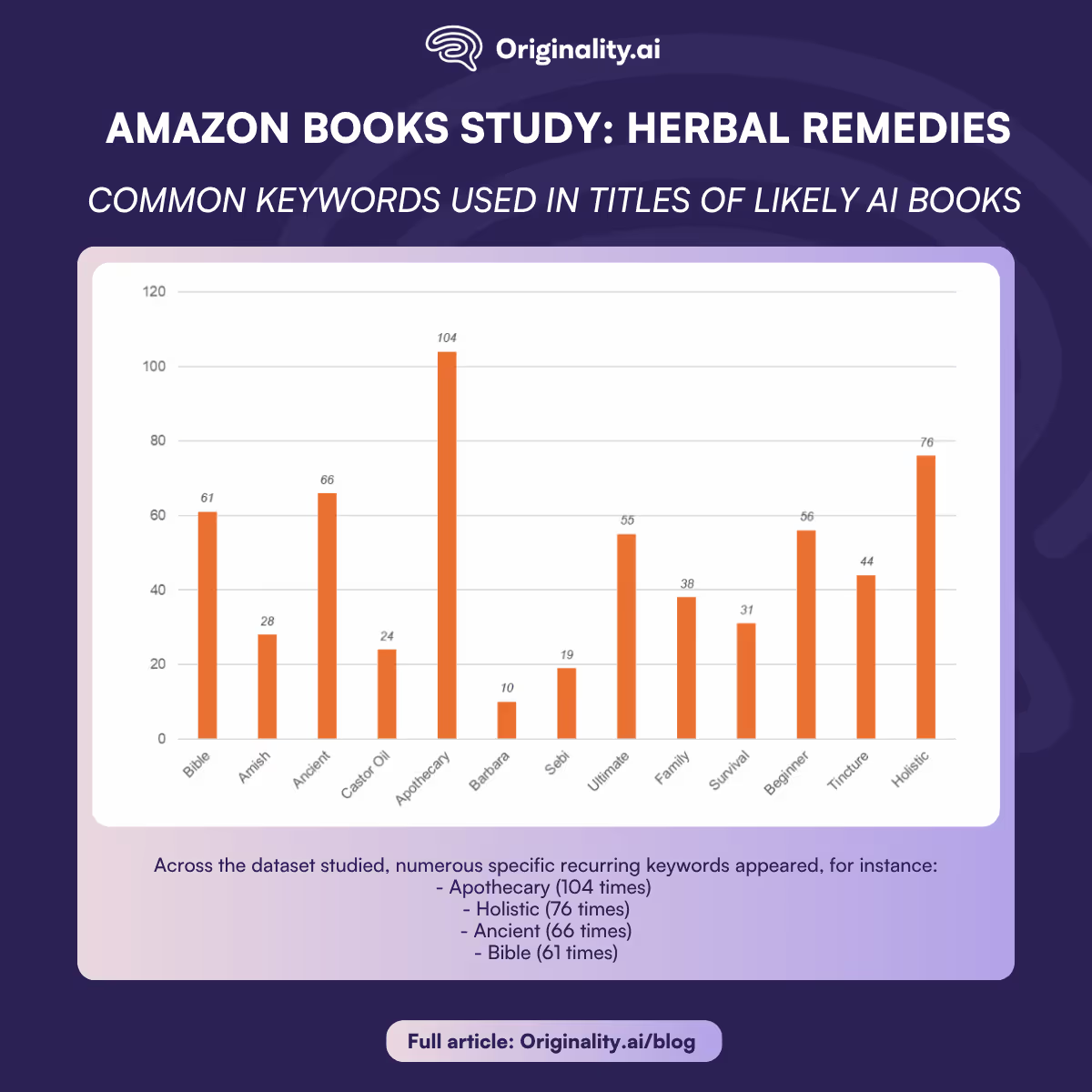
Other recurring words focused on specific characters.
There were 10 references in book titles to Barbara O’Neill (sometimes called “Dr. Barbara”, despite not being a doctor), a controversial Australian alternative medicine practitioner who has promoted anti-vaccine ideas and has been banned from disseminating medical advice in New South Wales.
Another 19 titles referenced Alfredo Bowman, a.k.a. “Dr. Sebi” (also not a doctor), a late Honduran herbalist who espoused herbal remedies for diseases including cancer and AIDS.
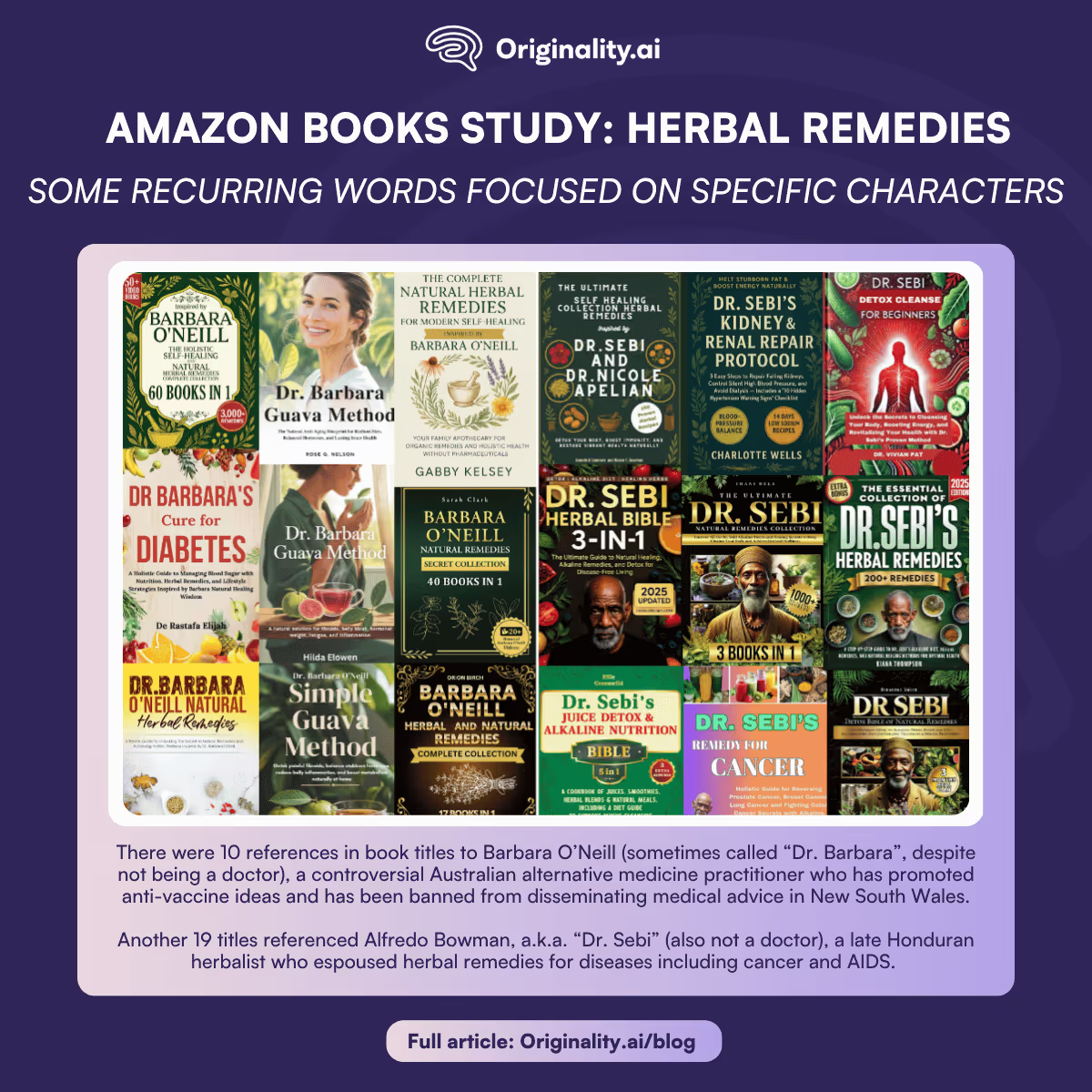
In combination, many of these keywords (“survival”, “Bible”, “Amish”, “natural”, “family”) illustrate a consistent aesthetic: independent, natural, Christian, family-oriented.
The ideal target consumer for these books is likely a Christian American mother with disposable income, distrustful of mainstream institutions—probably vaccine-skeptical—and concerned with protecting her family in a post-pandemic world.

If many of these covers appear to be copies of themselves, that’s not an accident. Sometimes, authors will create multiple versions of the same book, with slightly different covers, titles and summaries—like A/B testing in real-time.
In September, a fake author named “Buddy Cronin” probably used AI to create three different versions of a book piggy-backing off the popularity of a real English herbalist named Simon Mills. All are listed at the same price and were published within a week of each other.
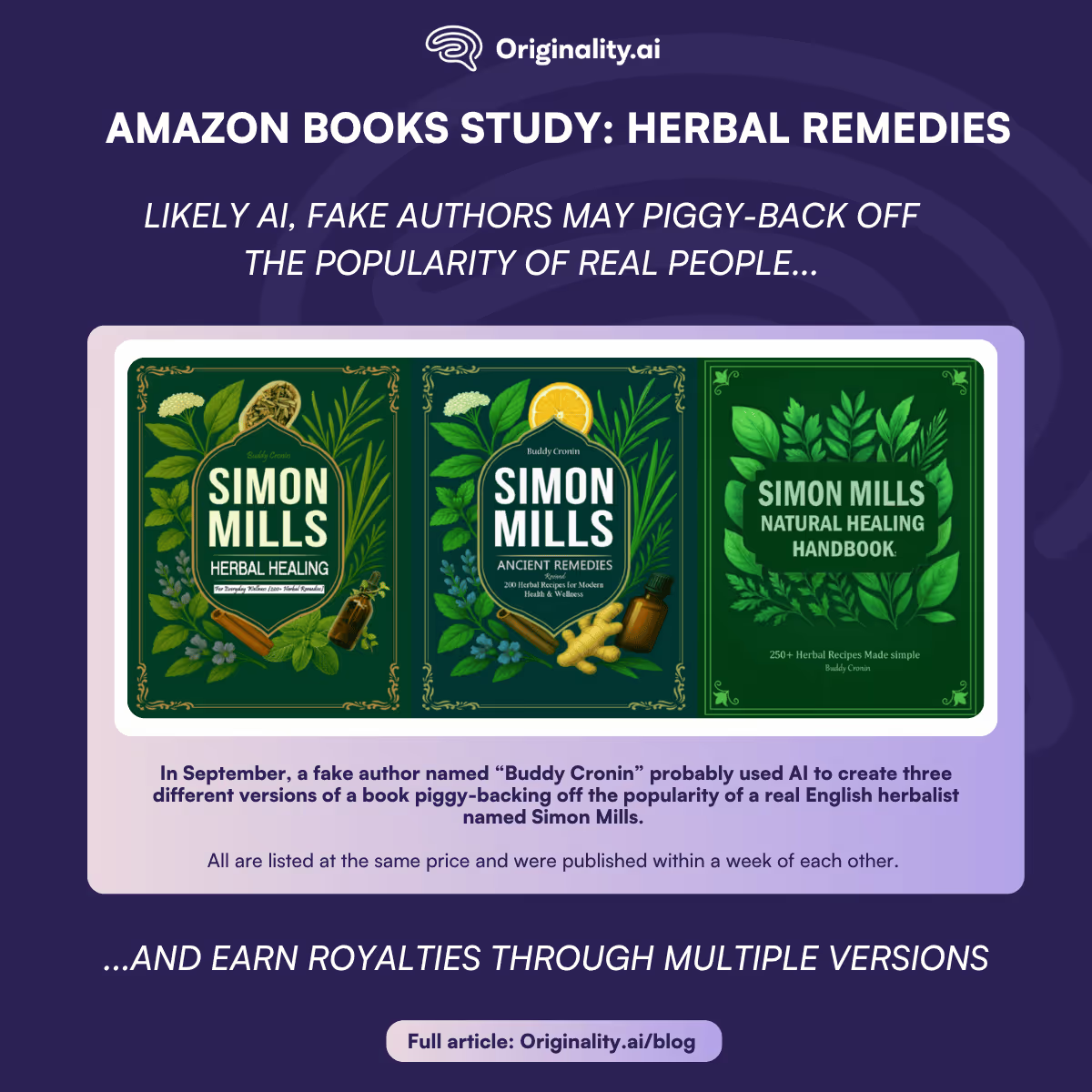
Sometimes, you’ll see a book like Tea Recipe Book: 300+ Healing Herbal Blends and notice it was written by a man named “George Teaman”. And you might think: Wow! What are the odds a dude named tea-man wrote a book about tea?
The odds are slim. Because Mr. Teaman doesn’t exist; his face, name and book are all likely AI-generated.
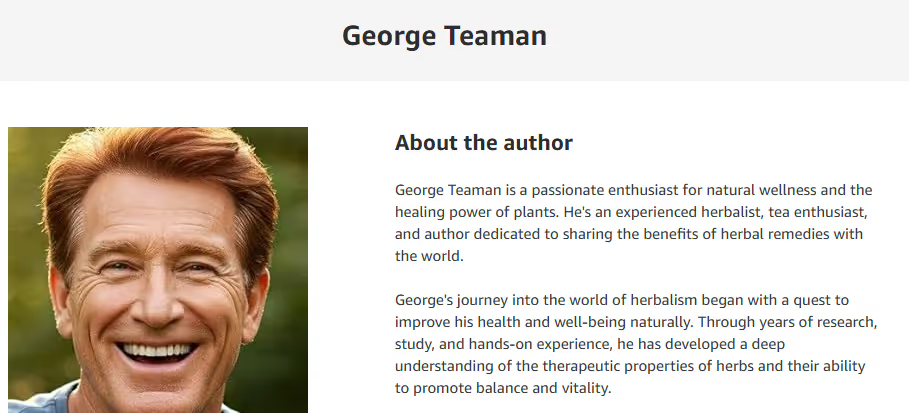
Of the 558 titles analyzed in this report, we found 489 unique authors. From that list, 177 contained common nature-themed words, such as “Green” (including Greenfield, Greene, etc.), “Wild” (Wilder, Wildroot) or “Rose” (Rosemary, Rosewell).
Some featured combinations of various crunchy keywords, like Juniper Rosewell, Julia Riverwood, Elara Greenleaf and Lark Meadowbrook. Others had surnames like Vance or Winslow, whose British origins refer to landscapes.
We compiled a list of 48 words that seemed suspiciously on-point, then omitted duplicate authors and cross-referenced the list against authors whose books were flagged as likely AI-generated. The result: of those 177 contrived monikers, 76% (134 unique names) likely used LLMs to write their books. That’s 29% of every AI suspect sampled.

This isn’t conclusive evidence that too-good-to-be-true names are AI-generated—after all, there are millions of Greens out there, and some could be herbalists. Also, writers have adopted pseudonyms over centuries for various reasons.
But if you find an herbalist book written by Violet Rivers or Jasper Vale, think twice before adding it to your Amazon cart.
And if you’re still not sure whether an author is fake, just scroll down to their biography.
Of the 558 author bios scanned, a clear plurality—38%—were likely AI-generated. The majority of authors didn’t have bios at all, or theirs fell below the 100-word-minimum threshold of Originality.ai’s scanner. Only 4% of authors in this dataset likely wrote their own bios—21 out of 489.
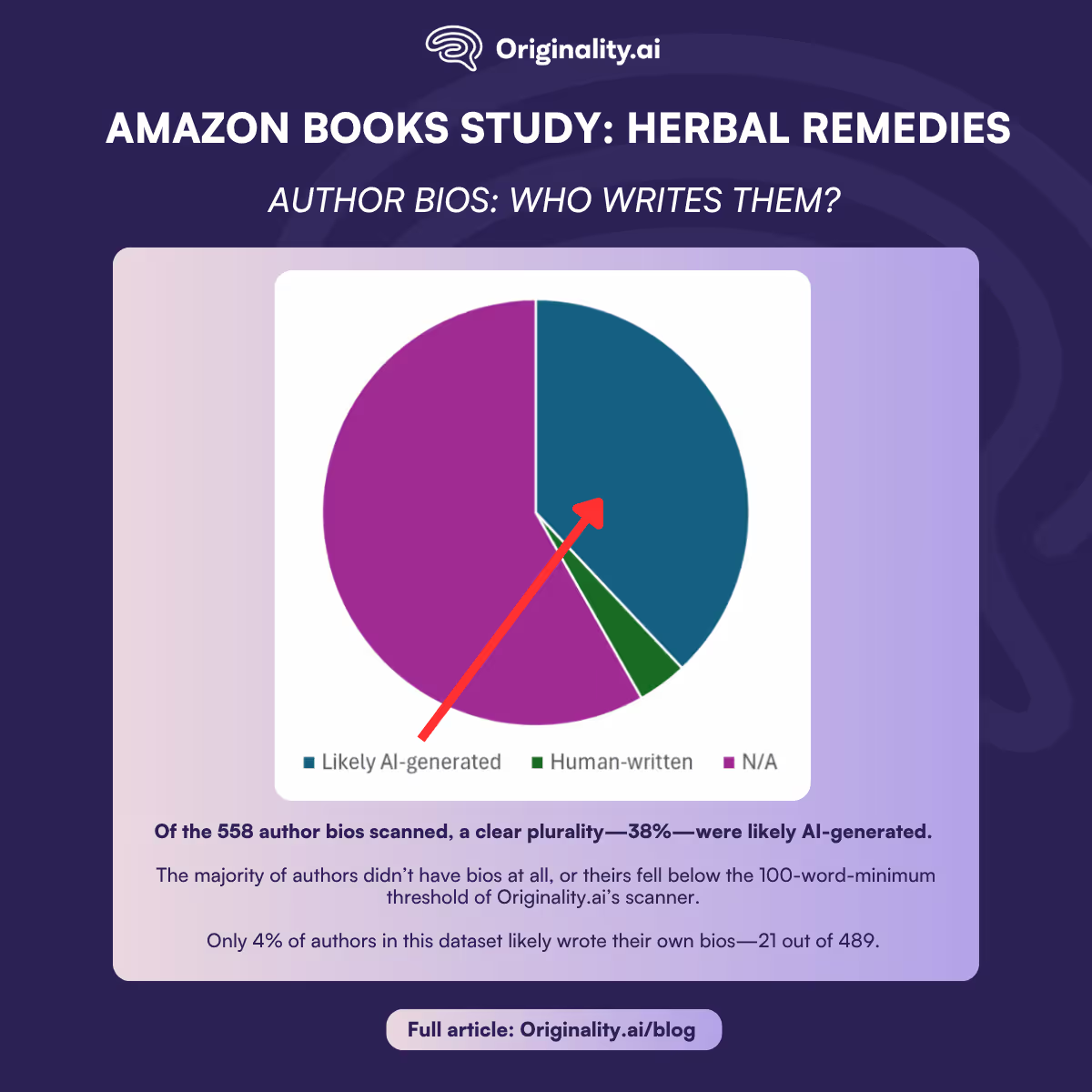
Authors who do have bios will also often publish their headshot. Originality.ai doesn’t scan images to detect AI, but don’t worry—to figure it out, sometimes all you need is a pair of eyes.
Some creators use tools that explicitly tell you they do not exist, like an AI-generating tool called this-person-does-not-exist.com, which watermarks all its images. Note the watermark at the bottom of this headshot of “Elsa K. Farms”, the apparently invented author of The Power of Anti-Inflammatory Diet—whose book contents, author bio and book summary were all flagged as likely AI-generated with 100% confidence.
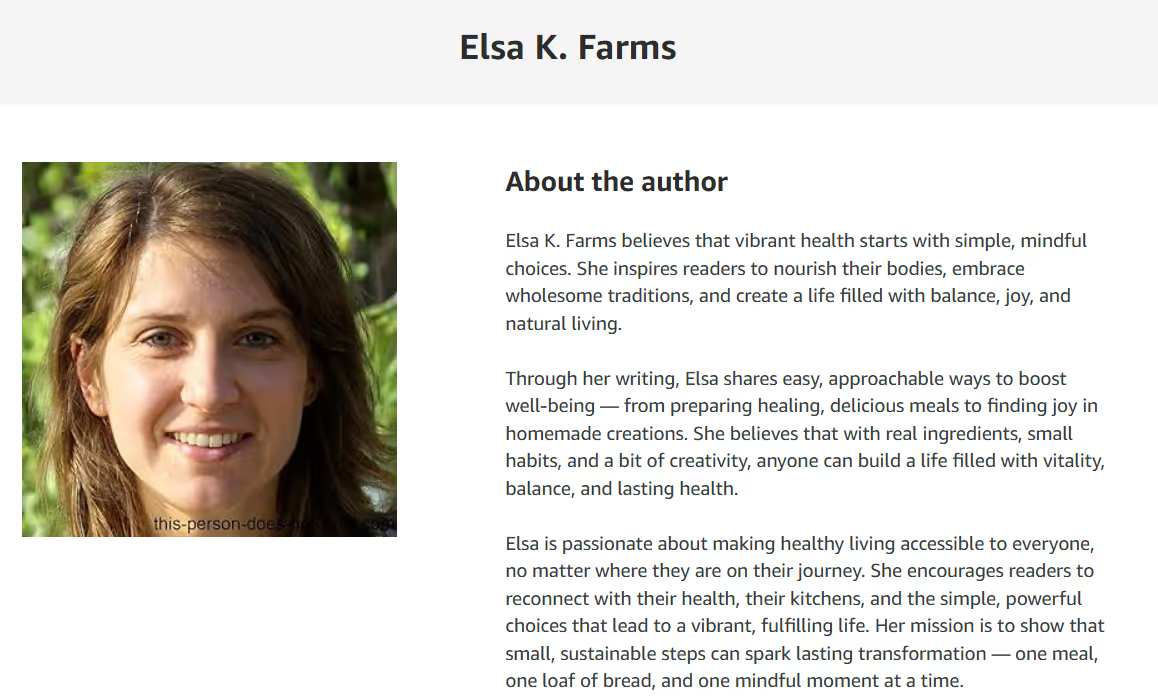
Some don’t even bother with fake photos at all—they’ll make AI-generated logos instead. Rosemary Gladwell (author of The Holistic Guide to Optimal Health), Liam Carter (The Modern Off-Grid Homestead) and Morgan Jacobs (The Herbal Tincture Apothecary) all seem to have used AI to create logos in lieu of AI-generated headshots.
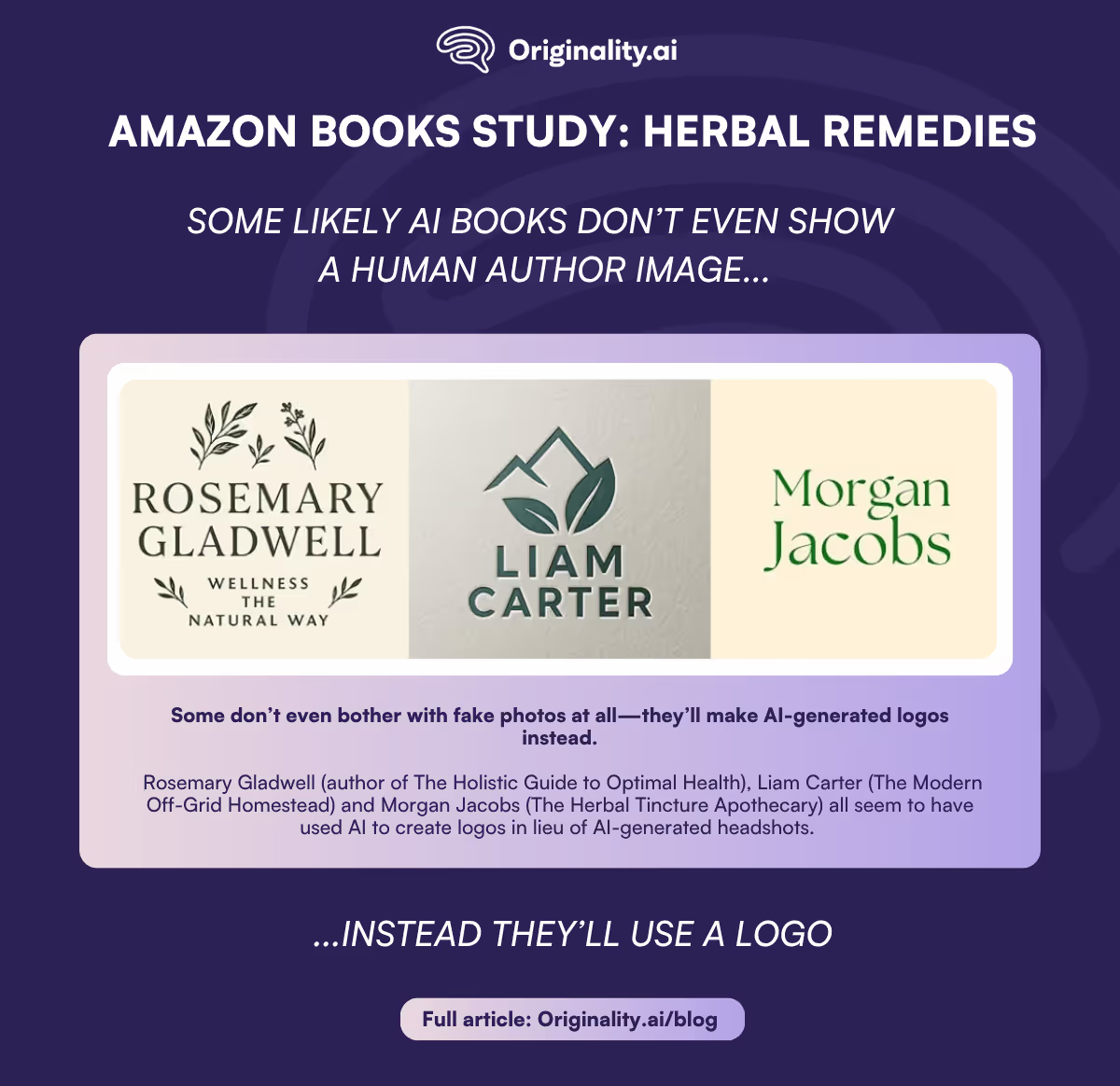
Amazon book summaries are a marketing tool, a teaser and lure to get you to click “Buy now”. It’s no surprise that LLMs would recycle the same phrases dozens of times over.
We input all 558 books’ summary text into Voyant Tools to detect which phrases recurred most often, and caught 18 with double-digit frequency:
We then cross-referenced these phrases against each title’s AI score, and found there was a near-total overlap. Some phrases, like “Are you tired of” and “Take control of your health”, have an astonishing 100% overlap in 66 and 83 instances, respectively.
Real people just don’t write this way.

These phrases are not obvious red flags in and of themselves, but if you look at enough of these books, you’ll notice the same patterns repeating over again—which makes sense, because LLMs are simply selecting words that best fit the patterns they’ve been trained on.
Anyone who’s used generative AI has noticed the tsunami of emojis LLMs use if left unfiltered. In Amazon book marketing, the floodgates are swung wide open.
We compiled a comprehensive list of every emoji we could find in the book summary data, and found that 45% of all book summaries included emojis—and almost all of them were likely AI-generated.
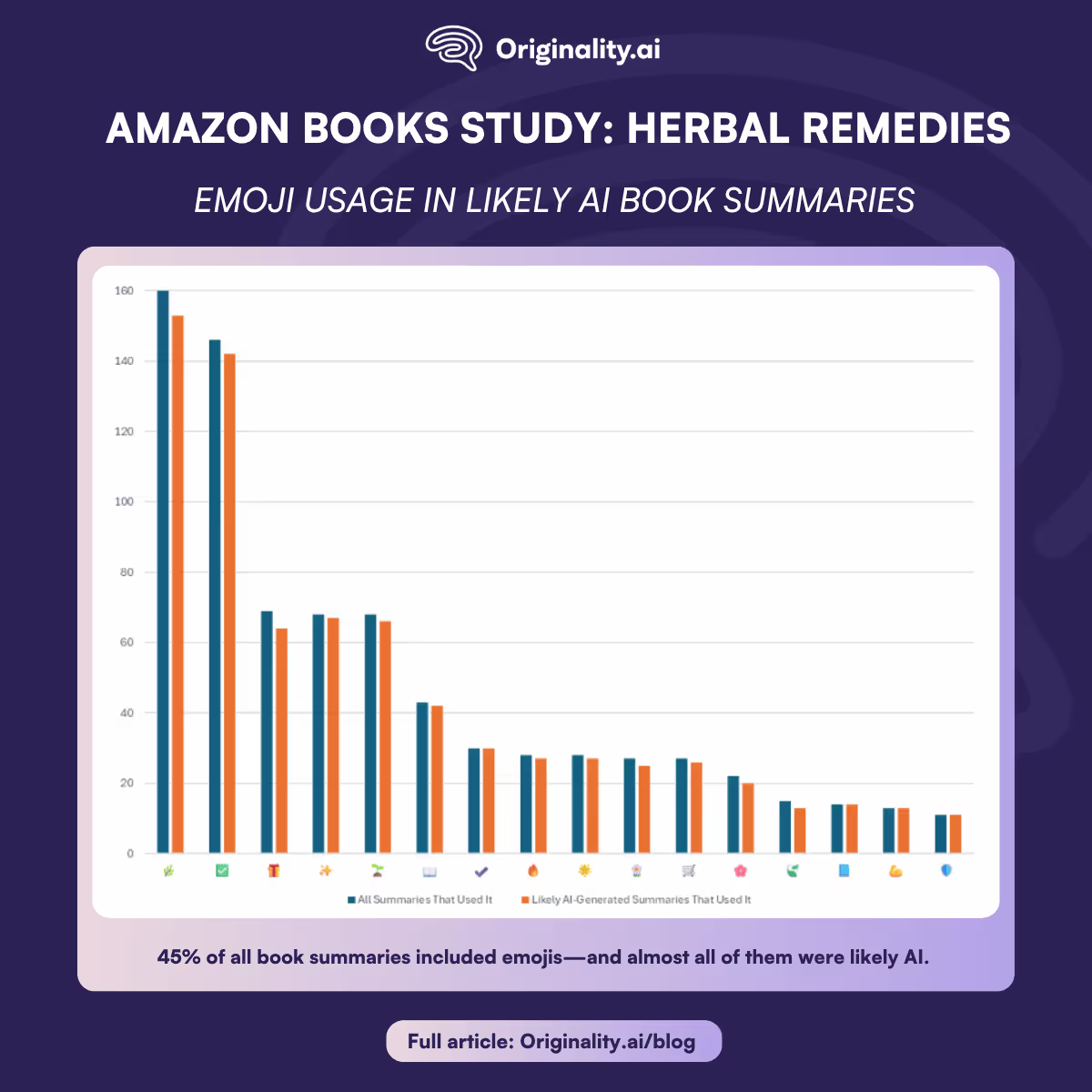
Out of the 558-book dataset, 251 used emojis in their book summaries. A near-perfect overlap of 244 summaries were flagged as likely AI-generated and contained at least one emoji.
That means only 6% of human-written books used emojis in their summaries, compared to 54% of likely AI-written books.
We cannot overstate how much LLMs writing about herbal remedies love the leaf (🌿) emoji. We found 153 unique summaries flagged as likely AI-generated that used it at least once—that’s 34% of all likely AI-written summaries.
After that, 142 likely AI-written summaries used the boxed checkmark (✅) at least once; 64 used the gift (🎁); 67 used the sparkle (✨) and 66 used the sapling (🌱).
All told, there were 2,885 emojis used in the entire dataset. Divided by the 251 books that used emojis, that’s an average of 11.5 emojis per book.
Not all LLMs use emojis—but those that do, do so in abundance.
To see inside the books themselves, we scanned what was available for viewing as a “Sample”. This content primarily comprised introductions, forwards, first chapters and tables of contents.
In each, the references and language were strikingly similar.
Many LLMs open their herbal remedies books by painting a picture of a person in pain, sometimes feeling overwhelmed in a supermarket or drug store aisle, before juxtaposing Big Pharma with the gentle breeze of a backyard garden. Some will invent memories of a grandmother and recall her “ancient wisdom”.
LLMs are significantly more likely to use this type of stereotypical language, juxtaposing the “modern world” (a phrase likely LLMs are 1,133% more likely to use) with “ancient remedies” (2,200%) that “you will discover” (1,033%).
Other disproportionately common phrases include “take control of your”, “the healing power of” and “ancient wisdom”.

AI is also not very creative. When asked to write books about herbal remedies, most LLMs return to the same herbs again and again.
One example that kept recurring: chamomile. Likely LLM authors wrote about chamomile in 175 books, comprising 31% of the whole dataset. Not far behind was ginger, which likely LLMs included in 154 books, then mint (156) and lavender (139).
That means probable LLMs are 237% more to mention chamomile than humans. Ginger is 196% more likely, mint is 212% more likely, and lavender is 202% more likely.
These stood out in stark contrast to less-common herbs, such as thyme and basil, which had fewer references overall—a significantly higher proportion of which were likely human-written. Basil was only 37% more common in likely AI-generated books; rosemary was 48% more common.
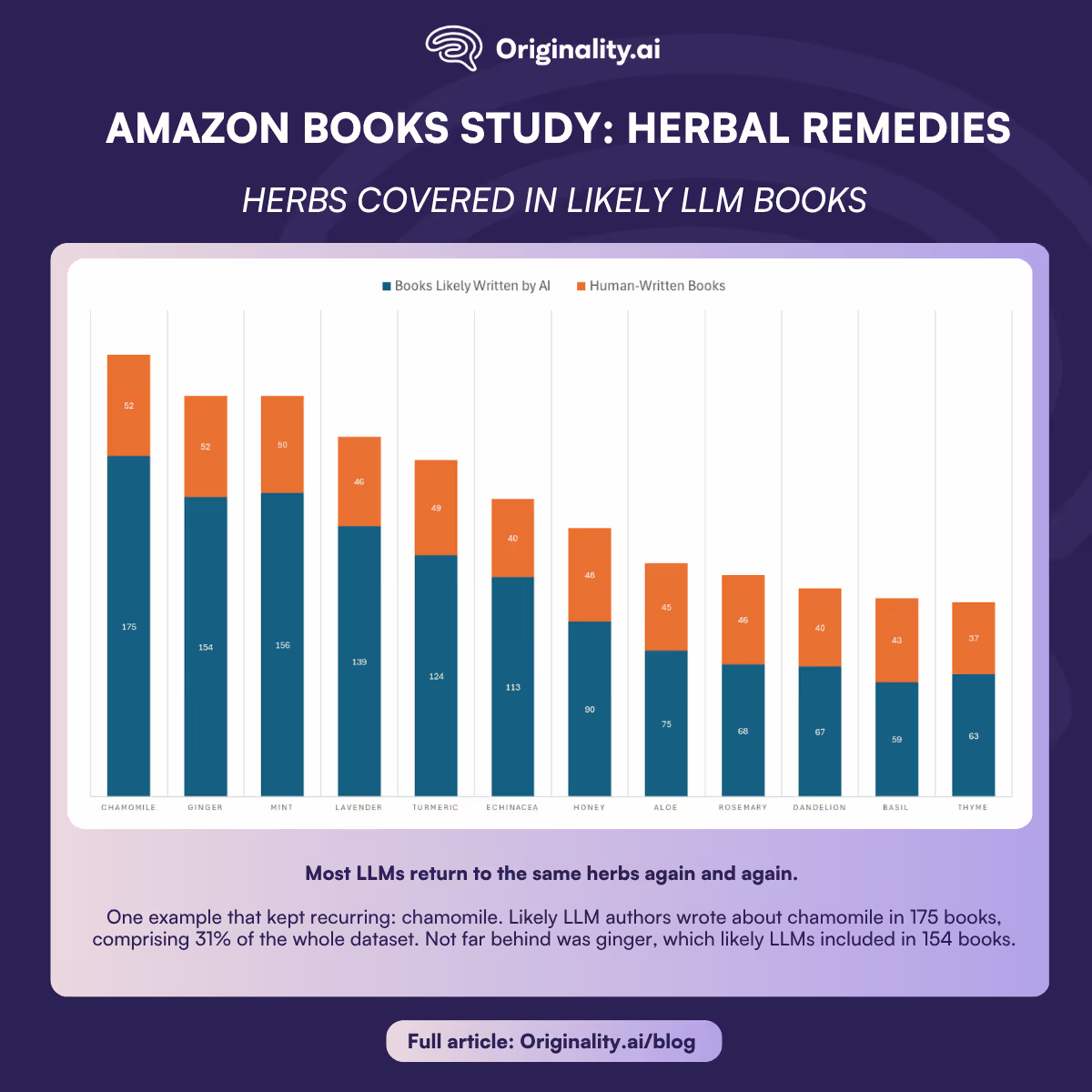
In Herbal Remedies for Beginners, probable LLM in disguise “Amelia Linwood”—whose book summary contains no fewer than 18 emojis—combines multiple AI writing tropes within the first chapter of her book:
When you think of healing, what comes to mind? For many, it is the sterile aisles of a pharmacy, lined with bottles and blister packs promising relief. But what if the path to wellness lay not in a plastic container but in the vibrant green leaves of your garden or the fragrant spices in your kitchen? My introduction to herbal remedies was like opening a door to a new and deeply familiar world. As a child, I watched my grandmother steep chamomile for upset stomachs and mint for headaches. These simple acts, which once seemed quaint, took on new meaning as I delved into the practice of herbalism.
Her book has 58 reviews, a 4.7-star average, and costs $14.99 in paperback.
Prices vary wildly for these books. For consistency, we looked exclusively at books that were available in paperback, and tracked the full price, noting discounts separately.
The average cost of these 558 paperbacks in Amazon’s “Herbal Remedies” subcategory for 2025 is US$19.07. Books whose sample text was flagged as likely AI were roughly 50 cents cheaper, at $18.51, while books probably written by humans were noticeably more expensive, averaging $21.68.
This makes sense: people who spend months, if not years, writing a book will charge more for their labour.
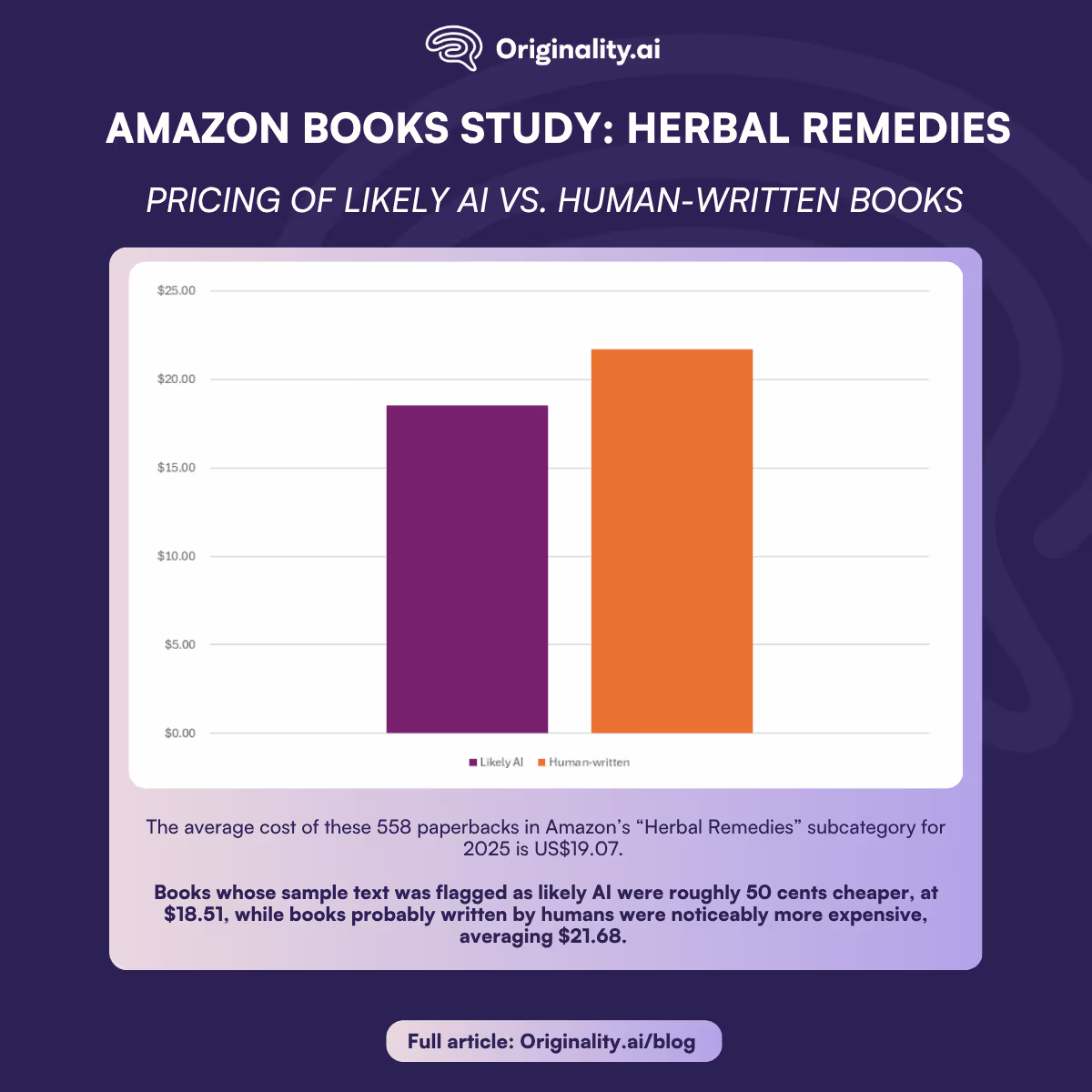
When we scanned the data over the span of a few days in October, we also checked whether any titles happened to be on sale at that time. Seven of the 103 likely human-written books were on sale, versus only two of the 455 likely AI-generated ones.
So AI content may be cheaper, but humans know how to fight back—with discounts.
Meanwhile, the average page count for all books was 183, with likely AI-generated books once again weighing things down at 173 pages. But humans raised the bar significantly, averaging 225 pages per book.
That means human-written books are 30% longer than ones likely written by AI. More expensive, but more bang for your buck.
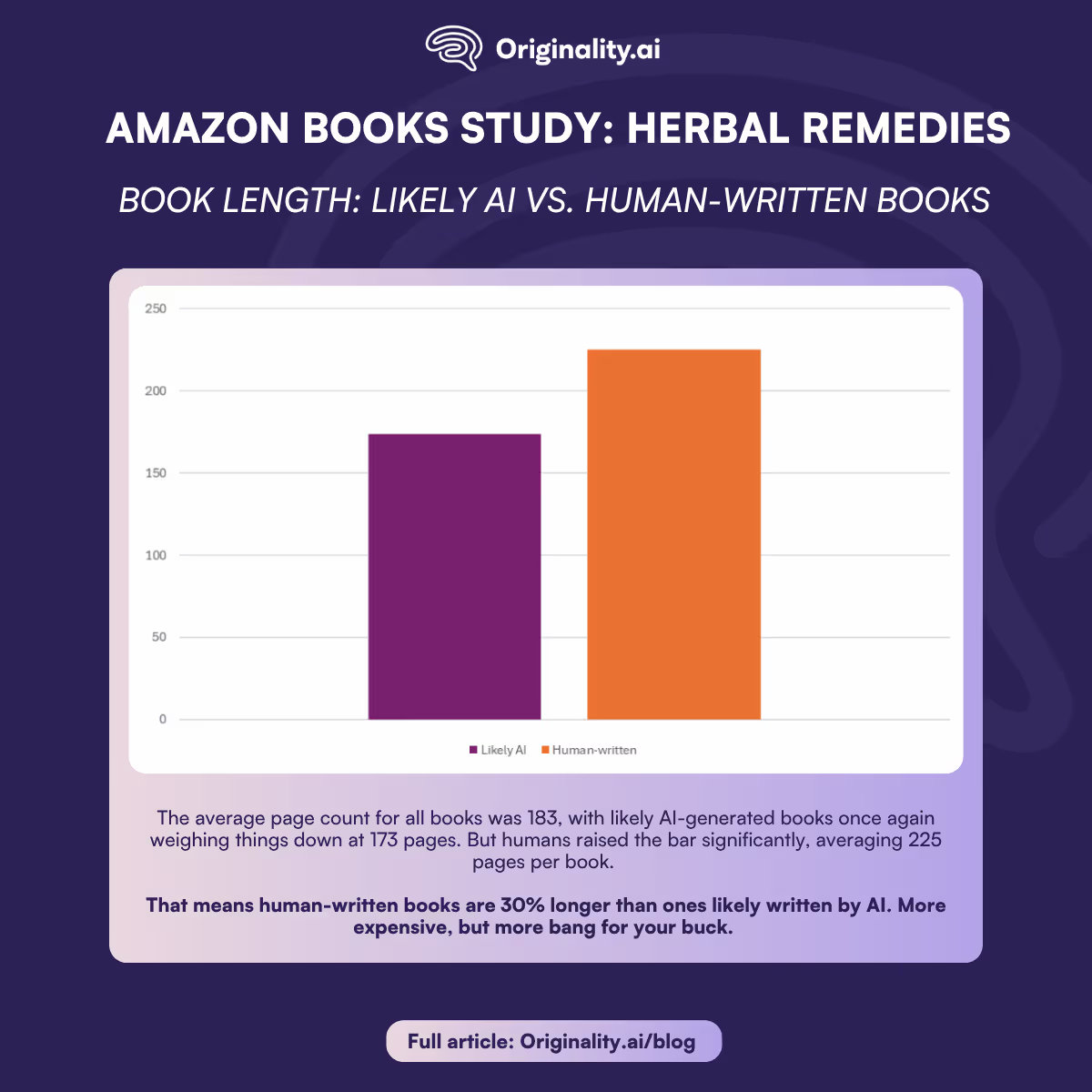
It is well documented that Amazon has struggled with fake reviews for years, long before AI came along. Nonetheless, there are real people leaving real reviews in there—and when the book is more likely to be written by humans, the reviews tend to multiply.
Books likely written by AI drew 22 reviews on average, while humans rocketed up with 34.9. That’s an average of 59% more reviews for likely human content.

It’s not a perfect metric, as plenty of AI titles reach bestseller status. But considering averages are in the 20s and 30s, every review counts.
It has been unrealistic to expect Amazon to check every single book being sold on its platform—but in the AI era, guardrails must be put in place. Installing something like a mandatory AI-checker for all books submitted to their platform would be a positive first step that could eliminate the vast majority of these titles.
In that situation, author bios and book summaries could remain exempt. These are marketing materials. Many authors want to write books, not sell them—which explains why dozens of human writers used AI to write their bios and summaries. AI-generated photos, however, should be banned, even if AI-generated names are too difficult to prove.
Regardless of its path, the onus is on Amazon to make changes that protect writers, consumers and its own brand from spiralling deeper into the depths of AI slop. The only reason they would take no action at all is because every book sold, regardless of whether a human or LLM wrote it, makes them money.
That would lead to a depressing and dangerous future for the publishing industry.
As of right now, consumers are responsible for avoiding AI content on their own. Some only realize what they’ve bought after it arrives at their doorstep.
A few folks who purchased Luna Filby’s best-selling title, The Natural Healing Handbook, learned this the hard way.
“Don’t know if I am missing something,” one reviewer wrote, “but I particularly wanted this book to help with Blood Sugar Balance, on page 84 there is a recipe for this, a list of ingredients and then in the instructions it tells you what to do with a completely different list of ingredients!!!”
Another person writes: “There are incomplete recipes in which the instructions were not written…”

Ismail G. from the U.K. is the only reviewer out of 518 who figured things out on his own: “I guess it is written by AI, full of inconsistencies.”
We looked at all books published in the “Herbal Remedies” subcategory between Jan. 1 and Sept. 30, 2025.
Because new self-published books appear on Amazon seemingly every hour, we decided to set clear filter limits. Each book must:
With those filters set, we scanned for multiple data points for each book page, including:
In addition, we reviewed three publicly available sections of text: the book’s summaries (also known as descriptions), author biographies and sample pages. All three text segments were bulk scanned by the latest Originality.ai model, Lite 1.0.2.
The resulting .xlsx file included columns for AI scores for each segment of text, and a TRUE/FALSE grade for whether that segment was likely written by AI.
When books’ bios or descriptions were under the 100-word minimum for Lite 1.0.2 to detect AI, our tool marked that field as N/A and moved on. When samples were unavailable or insufficient for scanning, the tool skipped those entries entirely.
We used Excel to cross-reference and visualize all data, Voyant Tools to get an overview of text trends, and CharacterCounter.com’s emoji counter to find the total number of emojis.

We believe that it is crucial for AI content detectors reported accuracy to be open, transparent, and accountable. The reality is, each person seeking AI-detection services deserves to know which detector is the most accurate for their specific use case.